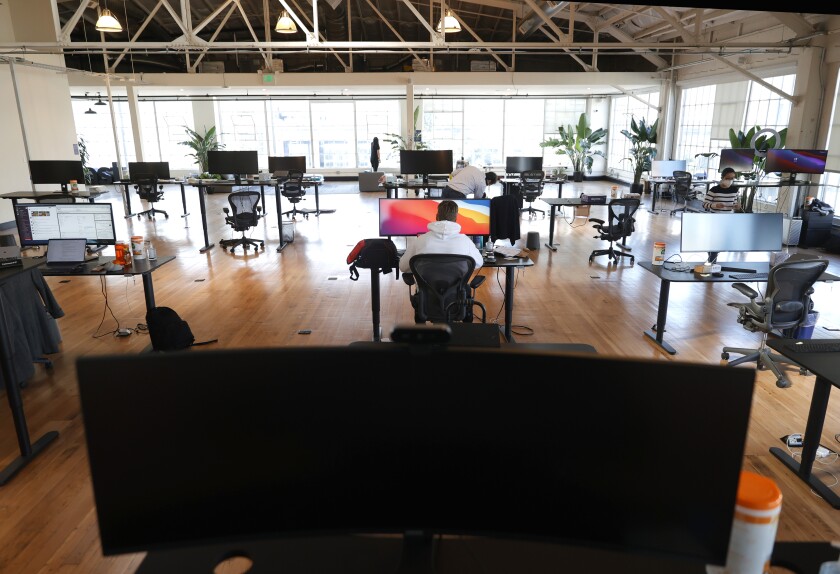The San Diego Union Tribune
June 25, 2021

Equal workplace status means that every person values every other person’s perspective and ability to contribute.
Hassaine is on the board of the Kim Center for Social Balance and lives in Downtown San Diego. Kim is the founder of the Kim Center and lives in Allied Gardens.
We throw out words like equity, diversity and inclusion a lot in society. We see them embedded in our corporate values, our national discourse and our personal aspirations. Many of us work hard to (rightfully) champion these values in our workplaces. That said, few can articulate the impact of these values on workers’ daily lived experiences in a measurable way. That is because diversity, equity and inclusion are in fact tools. What we are really aiming for is equal status for all employees.
Equal workplace status means that every person values every other person’s perspective and ability to contribute as much as they value their own, regardless of gender, race age, level of disability, etc. The opposite of equal status is discrimination, which reflects the belief that “you have less value than I because of your race, gender, education, etc.
Employers are trying to use equity to even the playing field, diversity to get the right people in the room and inclusion to make sure those people have a voice. However, labeling equity, diversity and inclusion as our goals is falling short of the mark. It is a bit like laser-focusing on lower blood pressure, stronger muscles and good teeth as comprehensive indicators of good health instead of how a patient actually feels. Our true goal should be for all employees to feel in their bones every day that they have equal status.
That is also when companies fully benefit from an equitable culture. Large-scale research from entities such as the Peterson Institute and Accenture demonstrates that companies investing intentionally in efforts to achieve greater balance between women and men in leadership positions correlates to increased profits and net margins. Companies that promote equal status for all genders externally and internally enjoy six times the innovation mindset of companies that do not. Employees who believe they are fairly treated and compensated, as well as physically and emotionally safe, stay in their jobs longer and are more productive.
The key word is intention. However, intention requires clarity, and clarity requires data. Unfortunately, there is a major flaw in the workplace justice movement that benefits discrimination: the decades-old, scattershot approach to collecting data and defining solutions that prevents us from understanding the actual pace of progress.
Women are the largest and most impacted group and at multiple intersections: including race, ethnicity, sexual orientation, caregiving, disability and/or veteran status. Discrimination against women in the workplace perpetually shapes and normalizes policies, data, practices and attitudes that reinforce an intractable cycle of disadvantage and privilege. Author Caroline Criado Perez tells this story well in her book “Invisible Women.” Perez investigated the root causes of gender inequality at home, at work, at the doctor’s office and more by unveiling how a lot of data on women is missing in economic development, health care, education and policy.
As a result, American employers collectively spend an estimated $8 billion every year on diversity and inclusion training, but 75 percent of those trainings do not move the needle because they fail to apply custom solutions built on each company’s data-driven narrative.
Luckily for us San Diegans, we have the Kim Center for Social Balance that is accelerating equal status for all genders in the workplace. The Kim Center works directly with companies and communities using trackable data to design and implement action plans at a small or large level.
People think that cultural transformation is going to happen on its own but that’s clearly not happening. We need a clearly structured program that combines the best of standardized metrics and custom strategies.
The Kim Center is a local nonprofit that uses its LEAPS initiative to optimize regionwide collaboration and track consistent metrics across industries and time. LEAPS helps employers and regional leaders accelerate cultural transformation through:
1) Assessment: comprehensive evaluation that combines quantitative and qualitative data (in partnership with UC San Diego Extension Center for Research and Evaluation)
2) Playbook: a tailored strategy based on assessment results that outlines goals, roles and timelines for all stakeholder groups
3) Accreditation: nationally standardized accountability across industries, regions and time that help employers understand where they rank in equal status levels
It is our responsibility to think and act on the realities of today’s workforce with the future in mind. What world do we want our kids to grow up in? One where companies are functioning at half their potential because of lower productivity, innovation, retention and access to talent? One where women make only 8 percent of the executive level? Or one where every person is equally heard and seen for the value they bring? Equal status will take time, diligence and investment, but it will pay off equally for all.

